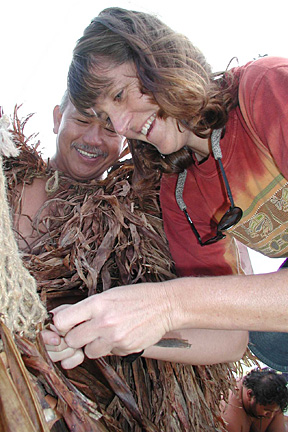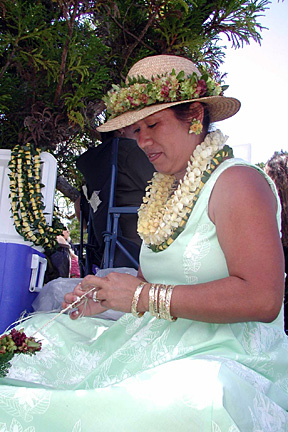
|
Hawaii’s
Back Yard |
Kilauea festival
passes on heritage
The Kilauea Cultural Festival is aloha in action. Each year, Big Island families donate fish, fruit, pigs and more for the samplings of traditional Hawaiian foods at this down-home celebration held at Kilauea Military Camp (see sidebar) in Hawaii Volcanoes National Park.
If you go ...What: 25th annual Kilauea Cultural FestivalPlace: Kilauea Military Camp front lawn, Hawaii Volcanoes National Park, Big Island Time: 10 a.m. to 3 p.m. Saturday Admission: Free; park entrance fees will be waived for this event Call: 808-985-6011 E-mail: havo_interpretation@nps.gov Web site: www.nps.gov/havo Notes: Wear sunscreen and a hat and bring water, a mat, a light sweater and a raincoat. The park is located at the 4,000-foot elevation, where the weather is unpredictable; it could be hot and sunny or cool and misty.
The entertainment10 a.m. -- Opening ceremony on the rim of Kilauea Caldera with Halau O Kou Lima Nani E hula school10:45 a.m. -- Hilo Serenaders 11:30 a.m. -- Puulena 12:15 p.m. -- Bill Kaiwa 1 p.m. -- Pandanus Club 1:45 p.m. -- Diana Aki 2:30 p.m. -- Kanikapila o Kilauea, a band featuring employees of Hawaii Volcanoes National Park and Kilauea Military Camp
|
Still others bring their treasured poi pounders, kapa beaters and pahu (drums) for use in hands-on demonstrations. Dozens more share their talent in music, dance and song.
It's all to perpetuate the Hawaiian culture, and park ranger Joni Mae Makuakane-Jarrell is quick to point out, "The biggest donation is love and time. Generations of families, from young children to kupuna (elders), have kept the festival going all these years."
It is fitting, then, that the theme for this year's 25th annual event is "E Hoomau i ka Poohala" ("Carry on the virtues, arts and skills of the family"). Since the festival's inception, Makuakane-Jarrell and her parents, children, brother, sister and nephews have been involved in one way or another, whether it be preparing food, demonstrating a craft, dancing hula or playing music.
Makuakane-Jarrell also is a member of the committee that organizes and implements the festival, but, she emphasizes, the event's success is due to the generosity and good will of many people, and this year will be no different.
She rattles off the names of several staunch supporters: "Puulena will be performing; they are continuing the music legacy of their parents, Robert and G-Girl Keliihoomalu, from Kalapana. Pele Hanoa, from Kau, and her ohana (family) will be teaching the art of lei making. Katherine Domingo, from Kona, will be weaving lau hala hats, and her son, Kilohana, will be demonstrating the intricate art of feather lei making. Hannah Acia passed away this year, but her daughter, Vicky Whitworth, will be carrying on her lau hala weaving skills, and another daughter, Ellen Cullen, will be sharing her beautiful voice with the audience."
More than two dozen demonstrations of ancient Hawaiian arts, crafts and activities will be vying for festival-goers' attention. For instance, you'll be able to learn how to fish using throw nets, make kahili (royal standards) from feathers, and play Hawaiian games and musical instruments. You can build a canoe or sled, carve a wooden bowl and practice lomilomi massage.
Decorating gourds, planting dry-land taro, studying medicinal plants, making ti leaf capes and sandals, and printing kapa patterns with bamboo stamps are among the other diversions planned. There will also be opportunities to "talk story" with knowledgeable kupuna.
The food-tasting booths always draw big crowds. "Nowhere else will you be able to try so many varieties of real Hawaiian food in one place," says Makuakane-Jarrell. "We don't just put food on a plate and say, 'Here, taste this.' We explain the work that goes into making each dish, so visitors understand it's not something they can buy in a store and pop in the microwave."
Last year, she recalls, people stood in line for hours to sample delicacies such as kalua pig, poi, sugar cane, sweet potato, breadfruit, haupia (coconut pudding), kulolo (taro pudding), poke (seasoned raw fish) and hoio (a native fern).

Charlie Hua showed visitors how to make a ti-leaf raincape at a past festival.
Although support from such entities has enabled the festival to grow, it has remained a grass-roots effort. It is the brainchild of four friends -- Minnie Kaawaloa, Helen Lee Hong, Fay Hanohano and Lei Pavao -- who worked at Wahaula Heiau Visitor Center in Puna before it was consumed by lava in 1989.
"Every year, we used to go to Puuhonua O Honaunau and Puukohola Heiau in Kawaihae for their cultural festivals," recalls Kaawaloa. "We would camp out and it was lots of fun. Then we thought, why travel so far? Why not stay home and do the same thing?"
So the women pooled their ideas and resources, got the community involved and staged the first Kilauea Cultural Festival at Kamoamoa, a beautiful coastal site in Puna. After Kamoamoa was overrun by lava in 1992, the event was moved to its current site at Kilauea Military Camp, where Mauna Loa and Mauna Kea volcanoes provide a magnificent backdrop.
Explaining the purpose of the festival, Kaawaloa says: "So many local people don't know their own culture. When we were children, we played ulu maika (bowling), palaie (ball and loop game) and other Hawaiian games. We learned how to weave lau hala, make kapa and other crafts. We created our own fun. We must continue to teach and share what was done in the past so that it can continue into the future. We must pass on the knowledge."
The Kilauea Cultural Festival now draws 3,000 people from around the Big Island for a full day of sharing na mea Hawaii, things Hawaiian. Makuakane-Jarrell believes its location in Hawaii Volcanoes National Park, the state's top attraction, is one reason for its enduring popularity.
Another, she says, is the aloha spirit. "The thing that sticks out in my mind is the commitment and support of the community over the past 25 years. About 250 volunteers help put on the festival each year. All the materials to make the arts and crafts are provided free of charge. People can take home their lau hala bracelets, their nose flutes, whatever they make, free of charge. At many of the other cultural festivals in Hawaii, the same items are sold. Here, everything is given away. And when you think about it, that's really the Hawaiian way."

Park Ranger Joni Mae Makuakane-Jarrell demonstrates lei-making at the Kilauea Cultural Festival.
Kilauea Camp offers rental cottages
Occupying 50 acres in Hawaii Volcanoes National Park, Kilauea Military Camp is a Joint Services Recreation Center open to all active and retired military personnel, Reserve and National Guard members, current and retired Department of Defense civilian employees, and their dependents and sponsored guests.It offers 77 one-, two- and three-bedroom apartments and cottages equipped with a small refrigerator, microwave, coffee maker, iron and ironing board, electric heat and a fireplace.
Amenities at the camp's lodge include bowling lanes, pool and pingpong tables, miniature golf, air hockey and video games. Golf, helicopter tours, charter fishing and other activities can be arranged at the lodge, and hiking and sports equipment are available for rent.
KMC's rates range from $52 to $133 per night, double occupancy, depending on the type of accommodations selected and the rank of the person making the booking. For reservations, call 438-6707 or e-mail reservations@kmc-volcano.com. Check out the Web site www.kmc-volcano.com for more information.
E-mail to Travel Desk
[News] [Business] [Features] [Sports] [Editorial] [Do It Electric!]
[Classified Ads] [Search] [Subscribe] [Info] [Letter to Editor]
[Feedback]
